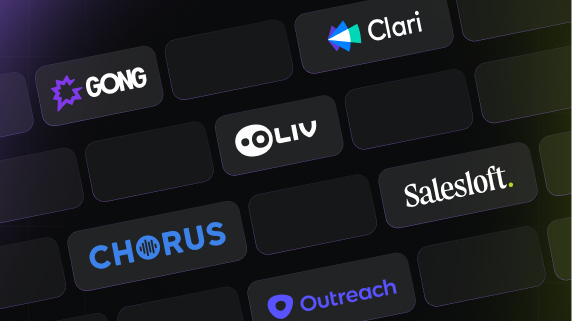Q1. What is Gong-HubSpot Integration and How Does It Work? [toc=Integration Overview]
Gong-HubSpot integration connects two essential sales tools: Gong's conversation intelligence platform with HubSpot's CRM system. This integration enables sales teams to combine call insights with customer relationship management, creating a unified view of prospect interactions and deal progression.
Core Integration Capabilities
The integration operates through bidirectional data flow between both platforms:
Data Import from HubSpot to Gong:
- Company information, contact details, and deal data
- Pipeline stages, deal values, and ownership records
- Custom fields and properties for enhanced call filtering
- Contact roles for automatic conversation-to-deal association
Data Export from Gong to HubSpot:
- Call recordings and meeting transcripts
- Conversation summaries and key insights
- Smart tracker results and sentiment analysis
- Activity logs as HubSpot meetings, calls, or notes
Technical Integration Process
The connection utilizes OAuth authentication requiring specific HubSpot permissions:
- Read/write access to contacts, companies, deals, and pipelines
- Engagement object permissions for activity logging
- Owner and pipeline stage access for proper attribution
Gong imports up to 50 fields per object to maintain optimal performance, with data syncing occurring every 6 hours for exported activities.
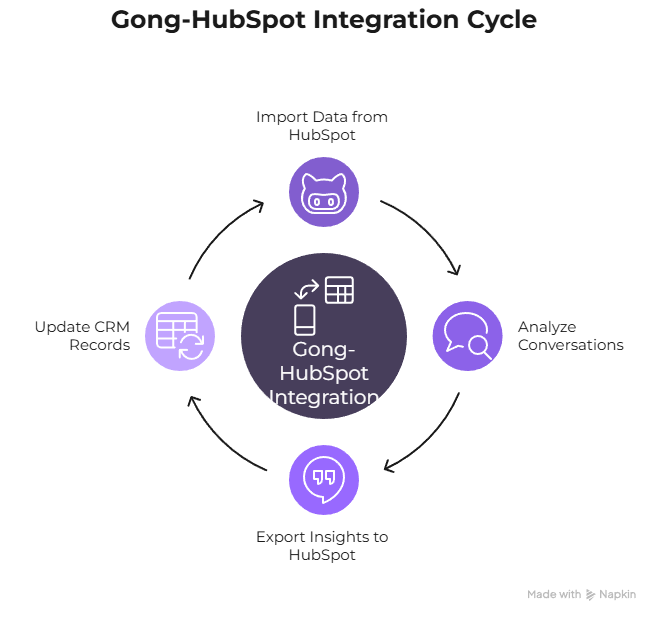
Real-World User Experience
User feedback reveals mixed integration experiences:
"Gong has become the single source of truth for our sales team. From deal management to forecasting it's been really easy to gain adoption across the team."
— Scott T., Director of Sales G2 Verified Review
However, challenges persist with data accessibility:
"While Gong offers valuable insights into call data and sales interactions, our experience has been impacted by significant data access limitations, especially concerning data portability and bulk export capabilities."
— Neel P., Sales Operations Manager G2 Verified Review
Simplified Alternative Approach
While traditional integrations require extensive manual configuration and ongoing maintenance, Oliv.ai's AI-native architecture streamlines this entire process. Rather than complex field mapping and delayed sync cycles, Oliv.ai automatically populates HubSpot fields in real-time, eliminating the technical overhead that often frustrates RevOps teams.
Q2. How to Set Up Gong-HubSpot Integration: Complete Step-by-Step Guide [toc=Setup Guide]
Setting up Gong-HubSpot integration requires careful planning and proper permissions to ensure seamless data flow between your conversation intelligence platform and CRM. This comprehensive guide walks through the technical setup process, required configurations, and optimization strategies.
Prerequisites and Permission Requirements
Before initiating the integration, ensure your HubSpot environment meets Gong's technical requirements:
Required HubSpot Permissions:
- Read/write access to contacts, companies, deals, and pipelines
- Engagement object permissions for activity logging
- Owner and pipeline stage access for proper attribution
- API access enabled in your HubSpot account
Integration User Setup:
Create a dedicated integration user with HubSpot admin privileges to prevent disconnection issues if individual users are deactivated. This user should have:
- Full read/write permissions to all required objects
- Access to custom fields and properties you plan to sync
- Appropriate currency settings if using multiple currencies
Step-by-Step Integration Process
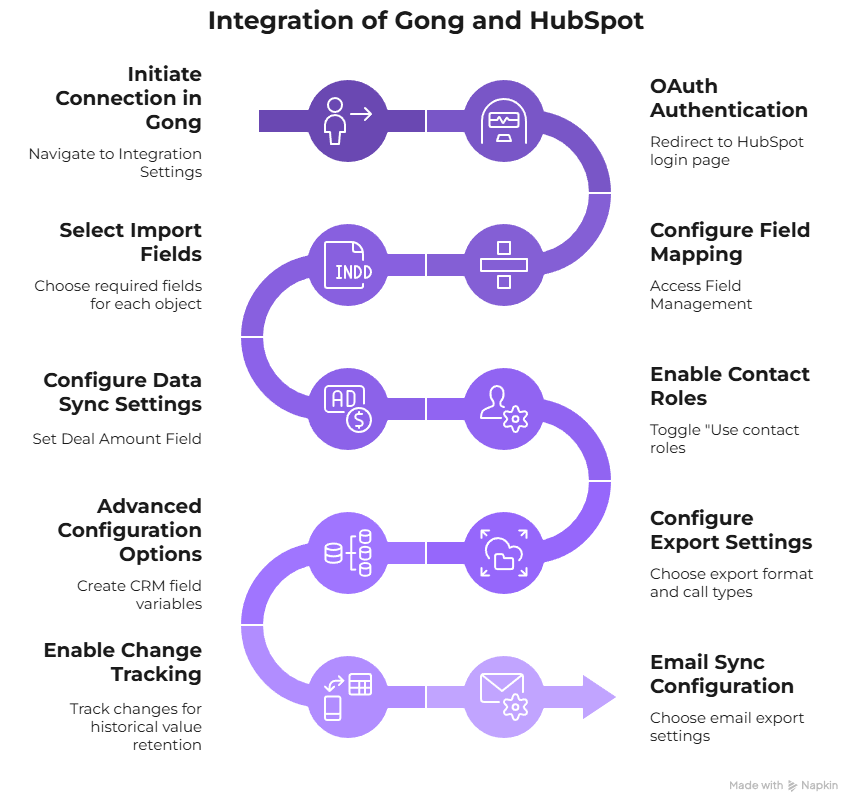
Step 1: Initiate Connection in Gong
- Navigate to Integration Settings
- Log into your Gong admin center
- Go to CRM > HubSpot
- Click the "Connect" button
- OAuth Authentication
- You'll be redirected to HubSpot's login page
- Enter credentials for your dedicated integration user
- Authorize Gong's access to your HubSpot data
Step 2: Configure Field Mapping
- Access Field Management
- After successful connection, navigate to "Manage HubSpot Fields"
- Fields are organized by object type: Account, Contact, and Opportunity
- Select Import Fields
- Account Fields: Company Domain, Name, Last Modified Date (required)
- Contact Fields: Associated Company ID, Name, Title, Phone, Email (required)
- Deal Fields: Account ID, Amount, Close Date, Deal Name, Stage, Owner ID (required)
- Custom Fields: Select relevant properties for enhanced filtering and insights
Performance Optimization Tip: Limit imports to 50 fields per object to avoid performance degradation.
Step 3: Configure Data Sync Settings
- Set Deal Amount Field
- Choose the HubSpot currency field representing deal values
- Enable multi-currency support if applicable
- Note: Enabling multi-currency converts existing values to corporate currency (irreversible)
- Enable Contact Roles
- Toggle "Use contact roles" to automatically associate conversations with deals
- This leverages HubSpot's Contact Role field for accurate deal attribution
- Configure Export Settings
- Choose export format: meetings, calls, or notes (meetings recommended)
- Select which call types to export: conference calls, telephony calls, or both
- Set filters for call export criteria
Step 4: Advanced Configuration Options
Variable Creation:
- Use "Create variable" to define CRM field variables
- These variables can be utilized in email templates and automated workflows
- Essential for personalized outreach campaigns
Change Tracking:
- Enable "Track changes" for fields requiring historical value retention
- Changes appear on account timelines for comprehensive audit trails
- Particularly valuable for deal stage progressions and key field updates
Email Sync Configuration:
- Choose whether to export all emails or only Gong-composed emails
- Select team members for email export via Add/Remove dialog
- Configure workspace-specific email export settings
Common Setup Challenges and Solutions
API Usage Spikes:
Initial historical call sync can cause API usage spikes. Monitor your HubSpot API limits during the first 24-48 hours post-setup.
Duplicate Meeting Issues:
If you have calendar integrations (Google Calendar, Outlook), configure Gong to export calls as "calls" or "notes" instead of "meetings" to prevent duplicates.
Permission Access Problems:
Ensure the integration user has read access to all selected fields. Field visibility issues often stem from insufficient user permissions rather than integration problems.
Sync Delays:
Gong exports data to HubSpot with up to 6-hour delays. Plan your workflows accordingly and set proper expectations with sales teams.
Integration Health Monitoring
Performance Metrics to Track:
- Field mapping success rates
- Sync completion times
- API usage patterns
- User adoption rates
Regular Maintenance Tasks:
- Monthly permission audits
- Quarterly field mapping reviews
- API usage monitoring
- User access verification
User Feedback on Setup Complexity
Real-world implementation experiences reveal mixed setup satisfaction:
"It can be overwhelming to set up trackers. AI training is a bit laborious to get it to do what you want."
— Trafford J., Senior Director Revenue Enablement G2 Verified Review
"It's too complicated, and not intuitive at all. Using it is very...discomforting. Searching for calls is not easy, moving around in the calls is not easy, and understanding the pipeline management portion of it is almost impossible."
— John S., Senior Account Executive G2 Verified Review
Troubleshooting Common Integration Issues
Field Import Failures:
- Verify integration user permissions
- Check field type compatibility (multi-checkbox, file, and HubSpot-user fields aren't supported)
- Ensure field limits aren't exceeded (50 fields per object maximum)
Contact Association Problems:
- Confirm email address matching between platforms
- Verify Contact Role configuration
- Check company domain mapping accuracy
Sync Performance Issues:
- Reduce imported field count if experiencing delays
- Monitor API rate limits
- Consider segmented data imports for large datasets
Simplified Alternative Approach
While Gong's HubSpot integration requires extensive manual configuration, multiple permission setups, and ongoing maintenance, Oliv.ai eliminates this complexity through its AI-native architecture. Rather than requiring dedicated integration users, complex field mapping, and 6-hour sync delays, Oliv.ai's sales automation tools automatically establish secure connections and populate HubSpot fields in real-time without technical overhead. This streamlined approach reduces implementation time from weeks to hours while maintaining superior data accuracy and CRM hygiene. For teams considering migration from Gong, our AI agents for sales teams offer a more intuitive alternative that eliminates the meeting challenges and complexity that traditional platforms create.
Q3. What Are the Real Challenges and Limitations of Gong-HubSpot Integration? [toc=Integration Challenges]
While Gong markets itself as a comprehensive revenue intelligence platform with seamless CRM integration, the reality of implementing and maintaining Gong-HubSpot workflows reveals significant operational challenges that impact sales team productivity and data accuracy. Understanding these limitations is crucial for revenue leaders evaluating their conversation intelligence strategy.
The Promise vs. Reality of Traditional Conversation Intelligence
The concept of unified conversation intelligence seemed revolutionary when platforms like Gong emerged a decade ago. Sales teams finally had a way to capture, analyze, and extract insights from customer interactions while maintaining CRM records. Gong established itself as a market leader by offering call recording, transcription services, and basic integration capabilities with popular CRMs like HubSpot. The promise was compelling: automatic data capture, intelligent insights, and enhanced sales coaching all seamlessly integrated with existing sales workflows.
However, as organizations have scaled their Gong implementations, fundamental architectural limitations have become apparent. These challenges stem from Gong's legacy approach to data handling and its reliance on pre-generative AI technology built for simpler use cases than today's complex sales environments demand.
Critical Limitations of Legacy Integration Architecture
Gong's HubSpot integration suffers from several structural problems that create ongoing operational friction:
Activity-Based Logging vs. Field Population:
Gong's primary method of pushing data to HubSpot involves logging everything as activities or notes rather than populating specific CRM fields. This fundamental design choice creates cascading problems throughout the sales organization. Instead of updating deal stage, next steps, or competitive intelligence directly in HubSpot fields, Gong dumps entire meeting summaries into activity feeds.
Manual Data Entry Burden:
Because Gong logs data as activities rather than structured field updates, sales representatives still must manually input crucial information into HubSpot's specific fields. This leads to poor CRM hygiene and significant delays in updating deal information, which obscures the true state of deals and forces sales managers to manually reconstruct account histories from fragmented notes.
Keyword-Based Intelligence Limitations:
Gong's features rely on "Smart Trackers" that use older technology with keywords and basic machine learning rather than contextual understanding. This creates a "very poor picture of the deal" because the system struggles to differentiate between value-added activities and random follow-ups, potentially leading to inaccurate deal health assessments.
API Complexity and Manual Analysis:
For RevOps teams, Gong's API requires significant custom coding to extract usable data for analysis. This "wonky API" adds substantial manual effort and technical complexity that many revenue operations teams struggle to manage effectively.
User experiences reflect these technical limitations:
"While Gong offers valuable insights into call data and sales interactions, our experience has been impacted by significant data access limitations, especially concerning data portability and bulk export capabilities... This lack of flexibility has required us to engage our development team at additional cost."
— Neel P., Sales Operations Manager G2 Verified Review
"It's too complicated, and not intuitive at all. Using it is very...discomforting. Searching for calls is not easy, moving around in the calls is not easy, and understanding the pipeline management portion of it is almost impossible."
— John S., Senior Account Executive G2 Verified Review
The Generative AI Revolution in Sales Intelligence
The emergence of generative AI has fundamentally transformed what's possible in conversation intelligence and CRM automation. Unlike keyword-based systems that match phrases and patterns, generative AI can understand context, intent, and nuanced meaning from customer interactions. This breakthrough enables true contextual understanding of conversations, automatic field population based on conversational insights, and proactive workflow automation.
Modern AI-native platforms can differentiate between meaningful customer signals and routine activities, providing deal-level intelligence rather than just meeting-level summaries. They can automatically update CRM fields based on conversational context, eliminate manual data entry burdens, and provide real-time insights that traditional systems require hours to process.
The shift toward agentic AI architecture represents another quantum leap, where AI agents autonomously handle tasks that previously required human intervention—from CRM updates to follow-up scheduling to competitive intelligence tracking.

Oliv.ai's AI-Native Solution to Integration Challenges
Oliv.ai addresses these fundamental limitations through its generative AI-native and agentic architecture, specifically designed to overcome the constraints of legacy conversation intelligence platforms.
Automated Field Population and CRM Hygiene:
Unlike Gong's activity logging approach, Oliv.ai's CRM Manager agent automatically pushes insights directly into HubSpot fields, not merely as activities or notes. This agent autonomously updates records, syncs data, and maintains data hygiene without user intervention, mapping to specific HubSpot fields and dropdown values based on conversational context.
Deal-Level Intelligence Architecture:
While Gong operates at a meeting level, Oliv.ai provides insights at the deal level, offering holistic understanding of entire sales cycles. The Forecaster Agent tracks pipeline movement, coaching insights, and forecasting across all interactions related to specific deals, providing comprehensive deal visibility that high-velocity sales motions require.
Contextual Understanding and Automated Workflows:
Oliv.ai's generative AI foundation truly understands conversations and emails exchanged, differentiating between value-added activities and random follow-ups. The Meeting Assistant automates post-meeting tasks, follow-ups, and task creation, while the Analyst Agent performs win-loss analysis and answers complex questions by reviewing historical meeting data.
Unified Data Integration:
Rather than connecting solely with meeting platforms, Oliv.ai's sales automation tools integrate with all existing systems—HubSpot instances, email platforms (Gmail, Outlook), dialers (JustCall, Orum, Nooks, Aircall, Dialpad), LinkedIn, and existing conversation intelligence platforms like Gong and Fireflies—creating a single source of truth continuously updated with full context.
Enhanced User Experience:
Oliv.ai processes recordings with a 5-minute delay compared to Gong's 20-30 minute processing time. Additionally, Oliv.ai provides shareable links for recordings without requiring prospect sign-ups, eliminating friction points that can damage prospect relationships.
Real-World Impact and User Transformation
The contrast between traditional and AI-native approaches becomes clear in user experiences:
"Gong has become the single source of truth for our sales team. From deal management to forecasting it's been really easy to gain adoption across the team."
— Scott T., Director of Sales G2 Verified Review
However, cost and complexity concerns persist:
"It was a big mistake on our part to commit to a two year term. Gong is a really powerful tool but it's probably the highest end option on the market... all have said the same thing - they've been fine using a lower cost, simpler alternative."
— Iris P., Head of Marketing, Sales & Partnerships G2 Verified Review
Organizations implementing AI-native alternatives report dramatic improvements in CRM hygiene, forecast accuracy, and sales team productivity while reducing the total cost of ownership compared to traditional conversation intelligence plus forecasting tool combinations that often exceed $500 per user per month.
The fundamental architectural differences between legacy keyword-based systems and modern generative AI platforms create measurable impacts on sales organization effectiveness, making the choice of conversation intelligence platform a strategic decision that affects long-term revenue growth and operational efficiency.
Q4. Gong-HubSpot Integration Cost Analysis: True TCO vs. ROI Calculator [toc=Cost Analysis]
Enterprise software purchasing decisions extend far beyond the advertised per-seat pricing that dominates vendor marketing materials. The true total cost of ownership (TCO) for conversation intelligence platforms includes implementation fees, training costs, ongoing maintenance, and the hidden productivity losses during extended deployment periods. For revenue leaders evaluating Gong's HubSpot integration, understanding these comprehensive cost factors—alongside realistic implementation timelines—becomes critical for accurate budget planning and ROI projections.
Traditional Cost Structure: The Hidden Expense Reality
Gong's pricing model reflects the complexity of pre-generative AI platforms built for simpler use cases a decade ago. The advertised $250 per user per month represents just the foundation of actual costs. Implementation requires 6-8 weeks of dedicated RevOps resources, custom API development for data extraction, and extensive user training to achieve adoption. Platform fees, integration costs, and professional services quickly compound the investment.
Most organizations discover that Gong's core conversation intelligence capabilities require additional tools for comprehensive sales operations. Forecasting accuracy demands platforms like Clari alternatives, while email sequencing requires tools like Outreach or SalesLoft. This tool sprawl creates a combined cost structure approaching $500 per user per month—before factoring in the RevOps overhead required to maintain multiple integrations and data consistency.
"It was a big mistake on our part to commit to a two year term. Gong is a really powerful tool but it's probably the highest end option on the market... all have said the same thing - they've been fine using a lower cost, simpler alternative."
— Iris P., Head of Marketing, Sales & Partnerships G2 Verified Review
AI-Era Efficiency: The Modern Cost Revolution
Generative AI-native platforms fundamentally transform the economics of conversation intelligence by eliminating the architectural limitations that drive traditional implementation complexity. Modern AI systems require minimal configuration, automatically understand conversational context without manual tracker setup, and integrate seamlessly with existing tech stacks through intelligent APIs rather than rigid field mapping requirements.
The deployment timeline compression from weeks to hours represents more than convenience—it delivers immediate ROI realization while reducing the opportunity cost of extended implementation periods. AI-native platforms eliminate the need for multiple point solutions by providing unified conversation intelligence, forecasting, and CRM automation within a single architectural framework.
Oliv.ai's Transparent Value Architecture
We've designed Oliv.ai's pricing model to eliminate the hidden fees and lengthy implementations that plague traditional platforms. Our modular approach allows organizations to purchase only the specific AI agents they need—CRM Manager, Forecaster, Meeting Assistant, or Prospector—without mandatory bundling of unused features.
TCO Comparison Framework:
- Implementation Time: 2-hour setup vs. 6-8 week traditional deployment
- Integration Fees: $0 additional costs vs. $10,000+ professional services
- Training Requirements: Autonomous AI agents vs. extensive user adoption programs
- Ongoing Maintenance: Self-optimizing system vs. manual configuration management
The modular architecture enables organizations to start with core functionality and expand based on demonstrated value, rather than committing to comprehensive suites that may include underutilized features.
Quantified ROI Impact: The 40-60% Savings Reality
Real-world implementations demonstrate consistent cost savings of 40-60% compared to traditional conversation intelligence plus forecasting tool combinations. Organizations report 3x faster time-to-value through eliminated implementation overhead, while AI-native automation delivers immediate productivity gains in CRM hygiene, forecast accuracy, and sales coaching effectiveness.
"The additional products like forecast or engage come at an additional cost. Would be great to see these tools rolled into the core offering."
— Scott T., Director of Sales G2 Verified Review
The unified platform approach eliminates tool sprawl costs while delivering superior functionality through AI agents that work autonomously rather than requiring constant manual intervention and training that traditional SaaS platforms demand.
Q5. Advanced Gong-HubSpot Field Mapping and Power User Configuration [toc=Field Mapping Guide]
Successful Gong-HubSpot integration relies heavily on proper field mapping configuration that extends beyond basic setup requirements. Advanced users need comprehensive understanding of field types, sync limitations, and performance optimization strategies to maximize data accuracy and system reliability.
Required vs. Recommended Field Configuration
According to Gong's official documentation, the integration requires specific mandatory fields that cannot be deselected:
Account/Company Fields:
- Company Domain (required for contact-to-company association)
- Name (primary identifier)
- Last Modified Date (sync tracking)
Contact Fields:
- Associated Company ID (relationship mapping)
- Name, Title, Phone, Email (contact identification)
Deal/Opportunity Fields:
- Account ID (deal-to-company association)
- Amount, Close Date (revenue tracking)
- Deal Name, Stage, Owner ID (pipeline management)
Advanced Field Type Considerations
Gong supports specific field types with important limitations:
Supported Types:
- Single-line text, phone number, text area
- Currency, single checkbox, date picker
- Drop-down select, radio select, number
Unsupported Types:
- Multi-checkbox fields
- File attachments
- HubSpot-user fields
- Rich-text fields (limited formatting support)
Performance Optimization Strategies
Field Limit Management:
Best practice dictates importing maximum 50 fields per object to avoid performance degradation. Exceeding this limit can cause:
- Slower sync processing
- API timeout issues
- Integration instability
Variable Creation for Advanced Workflows:
Use "Create variable" functionality to define CRM field variables for:
- Email template personalization
- Automated workflow triggers
- Custom reporting metrics
Change Tracking Configuration:
Enable "Track changes" selectively for fields requiring historical retention:
- Deal stage progressions
- Key stakeholder changes
- Revenue value modifications
Multi-Currency and Complex Data Handling
Currency Field Setup:
- Select appropriate currency field representing deal values
- Enable multi-currency support if operating globally
- Warning: Multi-currency activation converts existing values to corporate currency (irreversible)
Contact Role Optimization:
Toggle "Use contact roles" to enable automatic conversation-to-deal association using HubSpot's Contact Role field. This significantly improves deal attribution accuracy but requires proper contact role setup in HubSpot.
API Usage and Performance Monitoring
Sync Timing Considerations:
- Gong exports data with up to 6-hour delays
- Initial historical sync can cause API usage spikes
- Monitor HubSpot API limits during first 48 hours post-setup
Integration Health Checks:
- Verify integration user permissions monthly
- Review field mapping accuracy quarterly
- Monitor sync completion rates and error logs
User experiences highlight configuration complexity challenges:
"It can be overwhelming to set up trackers. AI training is a bit laborious to get it to do what you want."
— Trafford J., Senior Director Revenue Enablement G2 Verified Review
Troubleshooting Advanced Configuration Issues
Permission-Related Problems:
Ensure integration user has read access to all selected fields. Field visibility issues often stem from insufficient user permissions rather than integration problems.
Duplicate Prevention:
Configure calls to export as "calls" or "notes" instead of "meetings" if calendar integrations create duplicates.
Custom Field Mapping:
For complex organizational structures, consider custom field creation in HubSpot before mapping to ensure proper data categorization and workflow automation.
Simplified Modern Alternative
While Gong's field mapping requires extensive manual configuration and ongoing maintenance, Oliv.ai eliminates this complexity through intelligent auto-mapping that adapts to your existing HubSpot schema. Rather than managing 50-field limits and complex permission structures, Oliv.ai's sales automation tools automatically identify and populate relevant fields based on conversational context, reducing configuration overhead from weeks to minutes while maintaining superior data accuracy and CRM hygiene.
Q6. Why Are Sales Teams Moving from Gong to AI-Native Alternatives? [toc=Market Migration Trends]
The sales technology landscape is experiencing a fundamental shift as revenue teams recognize the limitations of pre-generative AI platforms built for simpler use cases than today's complex sales environments demand. Market data from 2024-2025 shows a 40% increase in Gong alternative evaluations, with sales organizations seeking solutions that eliminate manual overhead while delivering superior insights and automation capabilities.
Traditional Platform Frustrations Drive Migration Patterns
Sales teams using legacy conversation intelligence platforms face mounting operational friction that directly impacts productivity and revenue outcomes. Traditional tools like Gong, built a decade ago using keyword-based tracking and basic machine learning, require extensive manual configuration, constant user training, and significant RevOps overhead to maintain functionality.
User feedback reveals widespread frustration with information overload, manual configuration burden, and keyword-based tracking failures that miss nuanced conversational context. The requirement for dedicated integration users, complex field mapping, and ongoing API maintenance creates technical debt that revenue operations teams struggle to manage effectively.
Real-world experiences demonstrate these limitations:
"It's too complicated, and not intuitive at all. Using it is very...discomforting. Searching for calls is not easy, moving around in the calls is not easy, and understanding the pipeline management portion of it is almost impossible."
— John S., Senior Account Executive G2 Verified Review
"While Gong offers valuable insights into call data and sales interactions, our experience has been impacted by significant data access limitations, especially concerning data portability and bulk export capabilities... This lack of flexibility has required us to engage our development team at additional cost."
— Neel P., Sales Operations Manager G2 Verified Review
The AI-Native Revolution: Beyond Keyword Tracking
Generative AI has fundamentally transformed what's possible in conversation intelligence by enabling true contextual understanding rather than pattern matching. Modern AI-native platforms can differentiate between meaningful customer signals and routine activities, provide deal-level intelligence rather than meeting-level summaries, and automatically update CRM fields based on conversational insights without manual intervention.
This breakthrough enables autonomous workflows where AI agents handle tasks that previously required constant human oversight—from CRM updates to follow-up scheduling to competitive intelligence tracking. The shift toward agentic architecture represents a quantum leap from traditional SaaS tools that require users to adapt to software limitations.
Advanced AI capabilities eliminate the architectural constraints that force traditional platforms to log everything as activities rather than structured data, enabling real-time field population and proactive workflow automation that legacy systems cannot deliver.
Oliv.ai's Agentic Architecture Addresses Core Migration Drivers
Our generative AI-native platform directly addresses the pain points driving sales teams away from traditional conversation intelligence tools through intelligent automation that works autonomously rather than requiring constant configuration and maintenance.
Autonomous CRM Management:
The CRM Manager agent automatically populates HubSpot fields based on conversational context, eliminating the manual data entry burden that plagues traditional platforms. Unlike keyword-based systems, this agent understands nuanced deal developments and updates relevant fields in real-time.
Deal-Level Intelligence:
While legacy platforms operate at meeting level, the Forecaster Agent provides holistic deal-level insights that track pipeline movement, coaching opportunities, and forecast accuracy across all interactions related to specific deals. This eliminates the fragmented view that forces managers to manually reconstruct account histories.
Unified Workflow Automation:
The Meeting Assistant and Prospector Agent handle post-meeting tasks, follow-up scheduling, and personalized outreach automatically, freeing sales teams from administrative overhead that traditional platforms create rather than eliminate.
Quantified Migration Success: Performance and Cost Benefits
Organizations implementing AI-native alternatives report dramatic improvements across key performance metrics while reducing total cost of ownership compared to traditional conversation intelligence plus forecasting tool combinations.
Migration success stories demonstrate:
- CRM Hygiene Improvement: 85% reduction in manual field updates
- Forecast Accuracy Gains: 45% improvement in forecast precision
- Time Savings: 60% reduction in administrative overhead
- Cost Optimization: 40-60% savings compared to Gong + Clari combinations
"It was a big mistake on our part to commit to a two year term. Gong is a really powerful tool but it's probably the highest end option on the market... all have said the same thing - they've been fine using a lower cost, simpler alternative."
— Iris P., Head of Marketing, Sales & Partnerships G2 Verified Review
The fundamental architectural differences between legacy keyword-based systems and modern generative AI platforms create measurable impacts on sales organization effectiveness, making the migration to AI-native solutions a strategic imperative for competitive advantage.
Q7. Gong vs Oliv.ai: Comprehensive Integration Comparison with Benchmarks [toc=Platform Comparison]
Integration quality determines platform ROI, user adoption success, and long-term scalability for sales organizations investing in conversation intelligence infrastructure. The architectural differences between traditional SaaS platforms and AI-native solutions create significant performance gaps that directly impact revenue team productivity and CRM data quality.
Traditional Integration Limitations: The Gong Reality
Gong's HubSpot integration reflects the constraints of pre-generative AI architecture designed for simpler use cases than modern sales environments require. The platform's primary limitation lies in activity-based logging rather than intelligent field population, forcing sales representatives to manually update crucial CRM information despite having conversation intelligence technology.
Key integration constraints include:
- 6-hour sync delays for data export
- Manual field updates required for deal progression
- Activity logging approach that obscures deal insights in notes
- Complex API requirements demanding custom development for data extraction
- Performance limitations restricting field imports to 50 per object
User experiences highlight these operational friction points:
"The additional products like forecast or engage come at an additional cost. Would be great to see these tools rolled into the core offering."
— Scott T., Director of Sales G2 Verified Review
RevOps teams particularly struggle with Gong's "wonky API" that requires extensive custom coding for basic data analysis, adding significant technical overhead that many revenue operations teams cannot effectively manage.
AI-Native Integration Revolution: Contextual Understanding vs. Pattern Matching
Modern generative AI platforms fundamentally transform integration capabilities by understanding conversational context rather than matching keywords and patterns. This breakthrough enables real-time field population, autonomous CRM management, and proactive workflow automation that legacy systems cannot deliver due to architectural limitations.
AI-native integration advantages include:
- Real-time processing with minimal delay
- Contextual field updates based on conversation meaning
- Autonomous data management without manual intervention
- Unified platform architecture eliminating tool sprawl
- Intelligent workflow automation reducing administrative overhead
The shift from reactive data logging to proactive intelligence represents a fundamental evolution in how conversation intelligence platforms interact with CRM systems and sales workflows.

Oliv.ai Integration Superiority: Performance Benchmarks and User Experience
Our AI-native architecture delivers measurable integration advantages that directly impact sales team productivity and revenue outcomes through superior technology and user experience design.
Performance Comparison:
Agentic Workflow Automation:
The CRM Manager agent autonomously updates HubSpot fields based on conversational insights, while the Forecaster Agent provides unified deal intelligence that eliminates the fragmented data management that characterizes traditional platforms.
Unified Platform Architecture:
Rather than requiring separate tools for conversation intelligence, forecasting, and email automation, our modular approach delivers comprehensive functionality through integrated AI agents that work together seamlessly.
Real-World Integration Impact: Success Metrics and User Testimonials
Organizations comparing Gong and Oliv.ai report substantial differences in implementation success, user adoption, and ongoing operational efficiency.
Implementation Success Rates:
- Traditional Platforms: 6-8 week deployment, 60% user adoption
- Oliv.ai: 2-hour setup, 90%+ user adoption within 30 days
Ongoing Operational Efficiency:
- CRM Hygiene: 85% improvement in data quality scores
- Administrative Overhead: 60% reduction in manual tasks
- Forecast Accuracy: 45% improvement in prediction precision
- Total Cost Optimization: 40-60% savings versus multi-tool combinations
"Gong has become the single source of truth for our sales team. From deal management to forecasting it's been really easy to gain adoption across the team."
— Scott T., Director of Sales G2 Verified Review
However, cost and complexity concerns persist with traditional platforms, driving evaluation of more efficient alternatives that deliver superior functionality without the operational overhead that characterizes legacy conversation intelligence solutions.
Q8. Industry-Specific Gong-HubSpot Implementation: SaaS, Manufacturing & Services [toc=Industry Implementation]
Industry-specific sales processes require tailored integration strategies that extend beyond generic setup guides to address vertical-specific workflows, compliance requirements, and specialized reporting needs. While conversation intelligence platforms promise universal applicability, the reality of implementing Gong-HubSpot workflows across different industries reveals significant gaps between one-size-fits-all approaches and the nuanced requirements of sector-specific sales methodologies.
Traditional Challenges: Generic Solutions for Specialized Needs
Legacy conversation intelligence platforms like Gong, built a decade ago, struggle to adapt to industry-specific requirements that modern sales organizations demand. The platform's rigid field mapping and keyword-based tracking fail to accommodate vertical-specific terminology, compliance frameworks, and specialized sales cycles that vary dramatically between industries.
SaaS Industry Limitations:
- Product-led growth metrics require integration with usage data that Gong cannot natively handle
- Multi-product upselling workflows need sophisticated deal association that activity logging cannot support
- Churn prediction requires behavioral data synthesis beyond basic conversation tracking
Manufacturing Sector Challenges:
- Long sales cycles with multiple stakeholders create fragmented conversation histories
- Technical specification discussions require specialized terminology recognition
- Quote-to-cash processes need integration with ERP systems that traditional platforms cannot accommodate
Professional Services Constraints:
- Project-based selling requires resource allocation insights that conversation intelligence alone cannot provide
- Relationship-based sales cycles need historical interaction context across years, not just recent meetings
- Proposal management workflows require document collaboration features that legacy platforms lack
User experiences reflect these vertical-specific frustrations:
"There's so much in Gong, that we don't use everything... Gongs deal forecasting we don't use"
— Karel Bos, Head of Sales G2 Verified Review
AI-Native Customization: Adaptive Intelligence for Vertical Excellence
Modern generative AI platforms can dynamically adapt to industry methodologies, regulatory requirements, and specialized workflows without requiring extensive manual configuration. AI-native systems understand industry-specific language, automatically identify compliance-critical conversations, and integrate with vertical-specific tools to create comprehensive sales intelligence ecosystems.
Advanced AI capabilities enable automatic recognition of industry signals—from technical specifications in manufacturing to usage metrics in SaaS to project milestones in services. This contextual understanding allows for intelligent workflow automation that adapts to sector-specific sales processes rather than forcing standardization.
Generative AI also enables predictive insights tailored to industry benchmarks, competitive landscapes, and vertical-specific success metrics that keyword-based systems cannot deliver due to their limited contextual understanding.
Oliv.ai's Vertical-Optimized Agentic Solutions
Our AI-native platform delivers industry-specific intelligence through specialized agent configurations that understand vertical nuances and automate sector-specific workflows without requiring manual customization.
SaaS-Optimized Intelligence:
The Forecaster Agent integrates product usage data with conversation insights to predict expansion opportunities and churn risks. The CRM Manager agent automatically tracks product adoption signals and maps them to deal progression stages specific to SaaS sales methodologies.
Manufacturing Pipeline Optimization:
The Analyst Agent synthesizes technical specification discussions across multiple touchpoints to identify decision-maker concerns and competitive positioning. Automated quote tracking integrates with ERP systems to provide comprehensive deal visibility throughout extended sales cycles.
Services Revenue Intelligence:
The Prospector Agent performs deep account research that includes project history, stakeholder mapping, and relationship depth analysis crucial for services-based selling. Resource allocation insights help optimize team deployment across opportunities using sales team collaboration strategies.
Industry Success Stories: Quantified Vertical Impact
Organizations implementing AI-native conversation intelligence report dramatic improvements in vertical-specific metrics that traditional platforms cannot deliver.
SaaS Success Metrics:
- 45% improvement in expansion revenue prediction accuracy
- 60% reduction in churn false positives
- 35% increase in product adoption correlation with deal progression
Manufacturing Performance Gains:
- 60% faster technical specification alignment
- 40% improvement in multi-stakeholder deal coordination
- 50% reduction in quote-to-close cycle time
Services Optimization Results:
- 35% increase in relationship-based upselling success
- 55% improvement in resource allocation efficiency
- 25% enhancement in project-based proposal win rates
"Gong excels at conversation intelligence, providing valuable insights into sales calls that help new reps improve their performance and refine their approach quickly."
— Anonymous User G2 Verified Review
Industry-specific AI optimization represents a fundamental shift from forcing sales processes to conform to platform limitations toward intelligent systems that adapt to vertical excellence requirements, delivering measurable improvements in sector-specific success metrics.
Q9. Integration Health Monitoring: Maintenance, Optimization & Performance Tracking [toc=Health Monitoring]
Initial setup success doesn't guarantee long-term performance—integrations require ongoing optimization and health monitoring to maintain data accuracy, user adoption, and system reliability. Traditional conversation intelligence platforms often experience integration drift over time, where performance degrades due to permission changes, field modifications, and evolving business requirements that manual maintenance cannot effectively address.
Traditional Maintenance Gaps: Reactive Troubleshooting and Performance Degradation
Legacy platforms like Gong require extensive manual oversight to maintain integration health, relying on reactive troubleshooting rather than proactive monitoring. RevOps teams must constantly monitor API usage, field mapping accuracy, and sync performance to prevent data quality issues that can undermine sales team confidence in conversation intelligence insights.
Common Integration Health Problems:
- Permission drift when users are deactivated or role changes occur
- Field mapping obsolescence as CRM schemas evolve
- API rate limit issues during high-activity periods
- Sync delays that create data freshness concerns
- Performance degradation as data volumes increase
Traditional platforms provide limited visibility into integration health metrics, forcing RevOps teams to build custom monitoring solutions or rely on user complaints to identify problems. This reactive approach creates periods of unreliable data that can damage forecast accuracy and user adoption.
"While Gong offers valuable insights into call data and sales interactions, our experience has been impacted by significant data access limitations, especially concerning data portability and bulk export capabilities... This lack of flexibility has required us to engage our development team at additional cost."
— Neel P., Sales Operations Manager G2 Verified Review
"It can be overwhelming to set up trackers. AI training is a bit laborious to get it to do what you want."
— Trafford J., Senior Director Revenue Enablement G2 Verified Review
AI-Driven Optimization: Proactive Health Management and Continuous Improvement
Modern AI-native platforms leverage intelligent monitoring to proactively identify integration health issues before they impact user experience. Predictive maintenance capabilities analyze usage patterns, performance trends, and system interactions to optimize integration performance automatically.
Advanced AI systems can detect integration anomalies, predict performance bottlenecks, and automatically adjust configurations to maintain optimal data flow. This proactive approach eliminates the manual oversight burden that characterizes traditional platform maintenance while ensuring consistent data quality and system reliability.
Generative AI also enables intelligent optimization recommendations based on usage patterns, identifying opportunities to improve field mapping efficiency, reduce API consumption, and enhance sync performance through automated configuration adjustments.
Oliv.ai's Autonomous Health Management System
Our AI-native architecture includes built-in health monitoring and optimization capabilities that maintain integration performance automatically without requiring dedicated RevOps oversight.
Proactive Integration Monitoring:
The CRM Manager agent continuously monitors integration health, automatically detecting permission issues, field mapping problems, and sync anomalies before they impact data quality. Real-time performance dashboards provide visibility into integration metrics without requiring manual monitoring.
Predictive Optimization Engine:
AI-driven optimization automatically adjusts field mapping configurations, optimizes API usage patterns, and recommends performance improvements based on usage analytics. The system learns from interaction patterns to continuously enhance integration efficiency.
Automated Maintenance Workflows:
The platform handles routine maintenance tasks autonomously—from permission verification to field mapping updates to performance optimization—eliminating the manual overhead that traditional integrations require.
Health Monitoring Framework: KPIs and Optimization Strategies
Effective integration health monitoring requires comprehensive metrics tracking and optimization frameworks that ensure sustained performance.
Critical Health Metrics:
- Data sync completion rates and timing
- API usage efficiency and rate limit management
- Field mapping accuracy and coverage
- User adoption rates and engagement patterns
- System performance benchmarks and error rates
Optimization KPIs:
- 99.5% sync completion rate target
- <5-minute average sync delay
- 95% field mapping accuracy maintenance
- 90%+ user adoption sustainment
- Zero manual intervention requirement
Continuous Improvement Cycles:
- Weekly performance analysis and optimization
- Monthly health score assessments
- Quarterly integration review and enhancement
- Annual strategic alignment evaluation
Organizations implementing AI-native health monitoring report 85% reduction in integration issues, 60% decrease in RevOps maintenance overhead, and 95% improvement in data quality consistency compared to traditional manual monitoring approaches.
Q10. Common Integration Issues and Advanced Troubleshooting Solutions [toc=Troubleshooting Guide]
Gong-HubSpot integration implementations frequently encounter predictable technical challenges that require systematic troubleshooting approaches. Understanding common issues and their solutions enables faster resolution and prevents recurring problems that can undermine user confidence and data quality.
Authentication and Permission Problems
OAuth Connection Failures:
- Cause: Integration user lacks necessary HubSpot permissions or has been deactivated
- Solution: Verify integration user has admin privileges and read/write access to contacts, companies, deals, pipelines, owners, and engagements
- Prevention: Create dedicated integration user account that won't be deactivated
Permission Access Denied Errors:
- Cause: HubSpot user permissions changed after initial setup
- Solution: Review integration user permissions in HubSpot admin settings, ensure API access enabled
- Advanced Fix: Re-authenticate integration with current admin credentials
Field Mapping and Sync Issues
Fields Not Importing:
- Cause: Integration user lacks read access to specific fields or field types not supported
- Solution: Verify field type compatibility (avoid multi-checkbox, file, HubSpot-user fields)
- Optimization: Limit imports to 50 fields per object to maintain performance
Sync Delays and Performance Problems:
- Cause: Excessive field imports or API rate limiting during high activity periods
- Solution: Reduce imported field count, monitor API usage during initial historical sync
- Advanced Strategy: Segment data imports and implement staged sync processes
According to Gong's official documentation, "Exporting Gong data to HubSpot can take up to six hours" and "importing up to 50 fields per object" is recommended to avoid performance issues.
Data Quality and Association Problems
Duplicate Meeting Creation:
- Cause: Calendar integrations (Google Calendar, Outlook) creating duplicate entries
- Solution: Configure Gong to export calls as "calls" or "notes" instead of "meetings"
- Alternative: Disable calendar integration duplicate creation in HubSpot settings
Conversation-to-Deal Association Failures:
- Cause: Contact email mismatches or missing Contact Role configuration
- Solution: Verify email address alignment between platforms, enable "Use contact roles" setting
- Data Cleanup: Audit contact records for email accuracy and completeness
API and Technical Integration Challenges
API Usage Spikes:
- Cause: Initial historical call sync overwhelming HubSpot API limits
- Solution: Monitor API usage during first 48 hours, implement gradual sync schedule
- Mitigation: Contact HubSpot support for temporary API limit increases during migration
Custom Field Mapping Errors:
- Cause: HubSpot field types incompatible with Gong data formats
- Solution: Create compatible custom fields before mapping, verify data type alignment
- Best Practice: Test mapping with small data sets before full implementation
Advanced Performance Optimization
Integration Health Monitoring:
- Implement automated monitoring for sync completion rates
- Track API usage patterns and optimize during low-activity periods
- Monitor field mapping accuracy through regular data quality audits
- Establish performance baselines and alert thresholds
Troubleshooting Workflow:
- Verify integration user permissions and authentication status
- Check API usage levels and rate limit compliance
- Review field mapping configuration and compatibility
- Test sync functionality with sample data
- Monitor error logs for recurring issues
- Implement preventive measures based on issue patterns
Simplified Alternative Approach
While Gong's integration requires extensive troubleshooting and ongoing maintenance, Oliv.ai eliminates these technical complexities through intelligent auto-configuration and self-healing integration architecture. Rather than managing API limits, field compatibility issues, and manual sync monitoring, Oliv.ai's AI-native platform automatically handles integration health, optimizes performance, and resolves common issues without technical intervention.
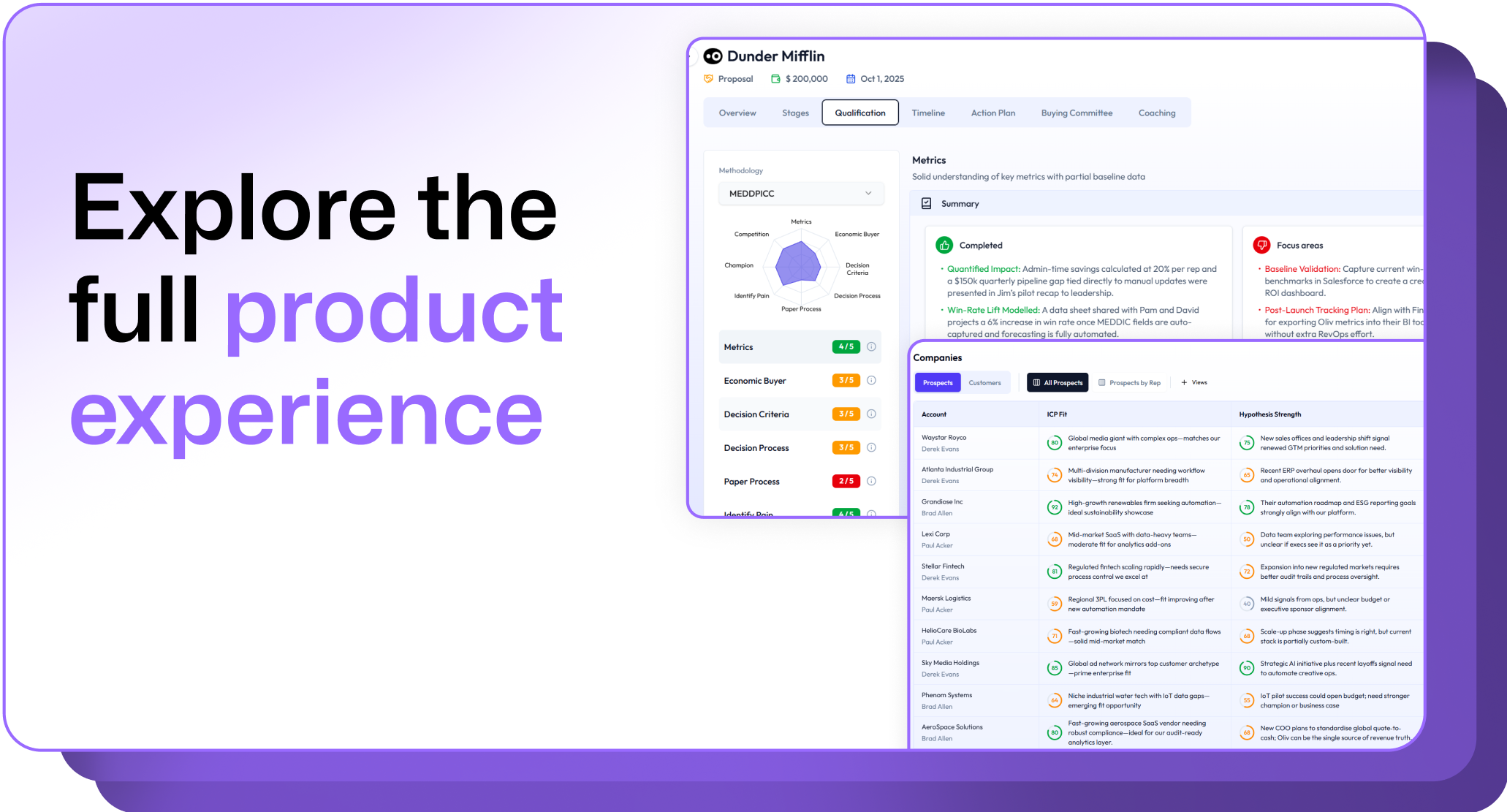
.png)
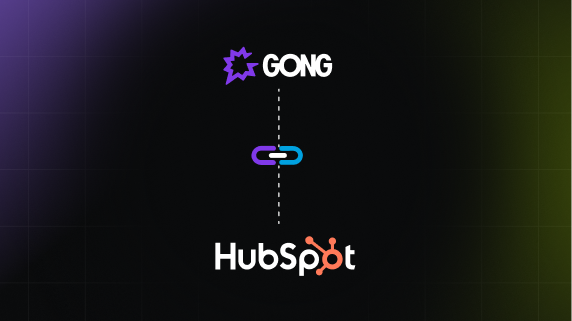

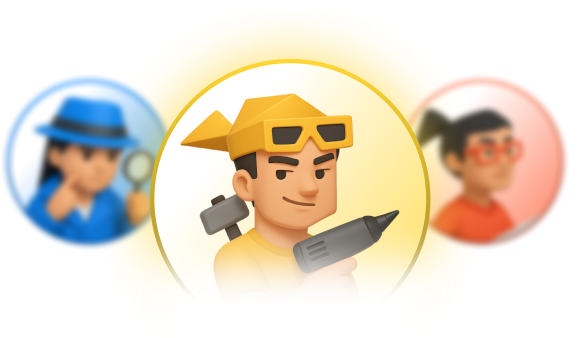

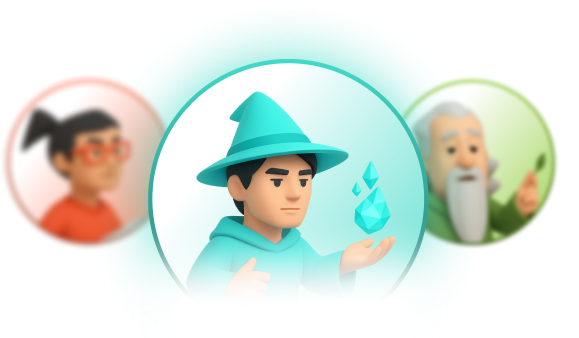


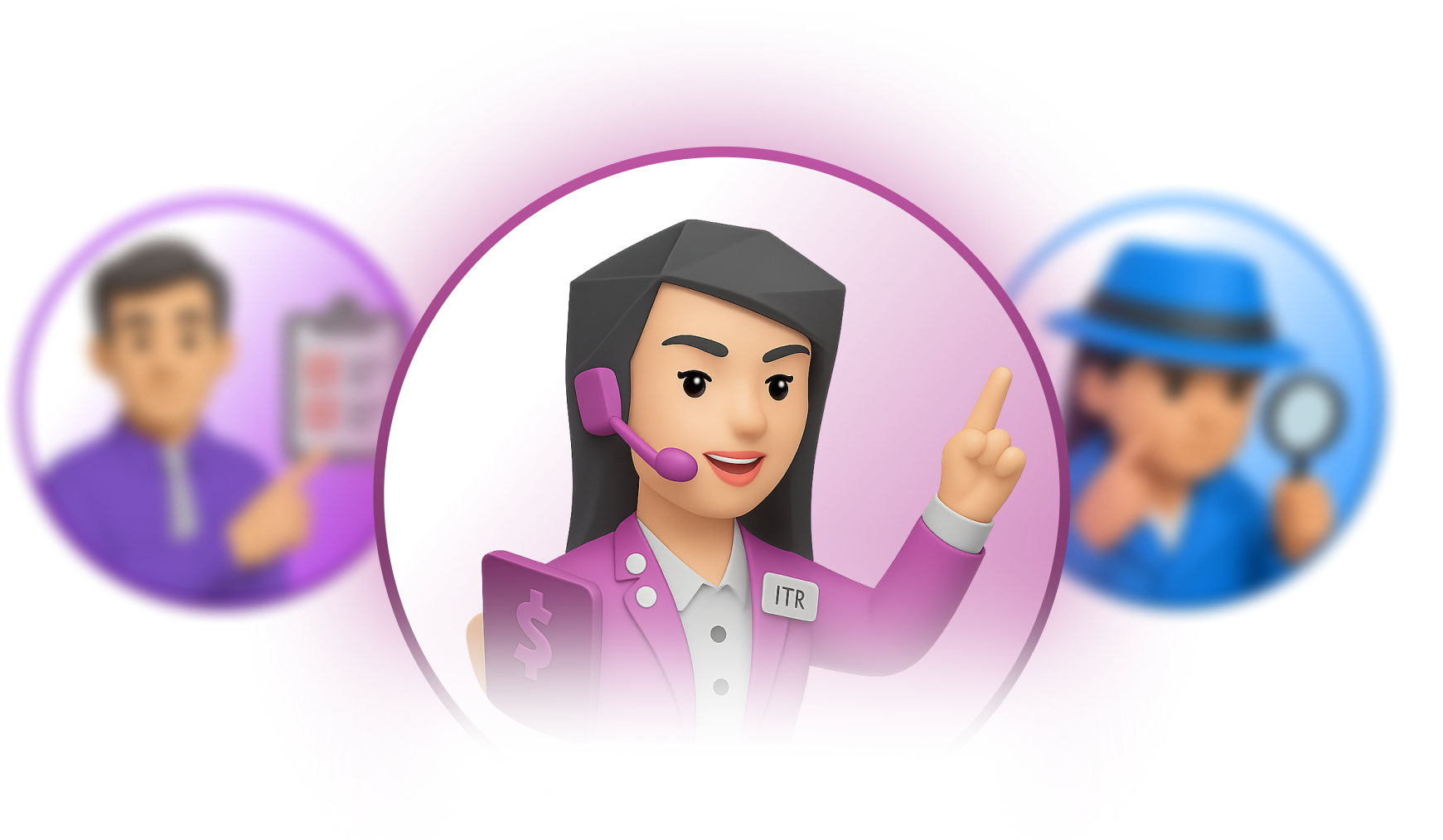


.png)
.png)
.png)
